1. Regarding whether or not the position mark in question falls under Article 3, Paragraph 1, Item 3 of the Trademark Act
Article 3, Paragraph 1, Item 3 of the Trademark Act provides to the effect that a trademark which consists solely of a mark indicating, in a common manner, the shape of a product (including the shape of packaging) etc. may not be registered. The purport of this provision is to disallow registration of the shape of goods etc. to be granted since:
(i) The marks described in said Item, especially the shape of goods etc. is, in many cases, selected for purposes such as more effective performance of functions that are expected of the goods etc., and improvement of the goods etc. in their aesthetic aspect. To the contrary, there are not many cases of the shape of goods etc. being used as an indicator for showing the source of goods or services, or for distinguishing them from other goods or services. As such, in many cases, customers recognize the shape of goods etc. as having been selected for emphasizing the function or aesthetics of goods, and they do not recognize the shape of goods etc. as having been selected as an indicator for identifying their source; and
(ii) A shape that is intended to contribute to the function or aesthetics of goods etc. is a shape which those who engage in a business of goods etc. of the same kind need and desire to use, and therefore, it is not appropriate from perspective of public interest to permit a particular person to exclusively use the relevant shape only on the grounds that such a particular person has first filed a trademark application therefor.
Accordingly, it is reasonable to interpret that the shape of goods etc. falls under Article 3, Paragraph 1, Item 3 of the Trademark Act as a trademark consisting solely of a mark that indicates the shape of goods in a common manner, unless there are special circumstances such as that the shape is beyond the scope of shapes that can be predicted to be adopted as a shape of goods etc. of the same kind for functional or aesthetic purposes.
With regard to the position mark in question consisting of the shape of a packaging container of the product specified below (the “Applied Trademark”), three-dimensional shapes consisting of vertically-long diamond shapes placed in a row on the surface of a packaging container for the designated goods “sauces for barbecued meat” in Class 30 constitute one of the three-dimensional decorations that are commonly adopted and used in transactions for packaging containers for sources for barbecued meat for the purpose of contributing to the function or aesthetics of the product, and the position is generally on the upper or lower part of a packaging container, and further, the shape thereof cannot be said to have a particularly innovative feature. Therefore, it is acknowledged that the three-dimensional shapes constituting the Applied Trademark and the position to which they are attached are within a scope predictable by customers and traders as those adopted for the reasons of function or aesthetics of goods etc.
Therefore, the Applied Trademark falls under Article 3, Paragraph 1, Item 3 of the Trademark Act.
① The Applied Trademark

② The detailed description of the Applied Trademark
2. Regarding whether or not Article 3, Paragraph 2 of the Trademark Act is applicable
Whether or not it can be said that a position trademark consisting of three-dimensional shapes has acquired distinctiveness through its use should be determined by comprehensively taking into consideration circumstances such as the shape of the trademark, the period and area of use of the trademark, the sales volume of the product bearing the trademark, the period and scale of advertising of the trademark, and whether or not there are other products having a shape that is similar to the shape of the trademark.
Considering the products for which the Applied Trademark is used (the “Products Bearing Applied Trademark”), according to the modes of the Products Bearing Applied Trademark, it is acknowledged that, in the Products Bearing Applied Trademark, the marks indicated on the label give a strong impression to consumers and consumers would focus on the said mark parts as an indicator for identifying the source of a product. On the other hand, considering the fact that the Applied Trademark consists of three-dimensional shapes that constitute one of the three-dimensional decorations that are commonly adopted and used in transactions involving packaging containers for sauces for barbecued meat for the purpose of contributing to the function or aesthetics of packaging containers, and is placed in a position near the label thereby creating a state in which it is not easily recognized as an indicator showing the source of a product, it cannot be acknowledged that, in the Products Bearing Applied Trademark, the three-dimensional shapes constituting the Applied Trademark would be recognized as an indicator for identifying the source of a product.
Even if products called “エバラ焼き肉のたれ 黄金の味” [meaning “Ebara Sauce for Barbecued Meat―Golden Taste” in English] came to be widely known, it cannot be said definitely that they would always be associated with the Products Bearing Applied Trademark. In addition, even if the sales performance of the Products Bearing Applied Trademark has reached a considerable level, it cannot be acknowledged that the three-dimensional shapes constituting the Applied Trademark are recognized as an indicator for identifying the source of a product. Furthermore, it is found that in TV commercials, the time during which the three-dimensional shapes constituting the Applied Trademark and placed on the surface of the container of the Products Bearing Applied Trademark appeared so as to be visually recognizable on the screen, was short in duration, and it is also found that it was difficult for listeners of radio commercials to recognize the three-dimensional shapes constituting the Applied Trademark. Further, it cannot be acknowledged that, in other advertisements, there were announcements or indications intended to cause the three-dimensional shapes per se to give a strong impression as an indicator for showing the source of the product, or as an indicator for distinguishing the product from other products. And it is acknowledged that the questionnaire of the present case cannot be considered reasonable for making a selection between the container of the Product Bearing Applied Trademark and the containers that were used for comparison.
Therefore, it cannot be acknowledged that the Applied Trademark corresponds to a trademark which has acquired distinctiveness through use as set forth in Article 3, Paragraph 2 of the same Act.
1. Regarding the summary of Judgment 1, the Court found that the shape of goods etc. does not have inherent distinctiveness and falls under Article 3, Paragraph 1, Item 3 of the Trademark Act as a trademark consisting solely of a mark indicating the shape of goods in a common manner, unless there are special circumstances such as that the shape is beyond the scope of shapes that can be predicted to be adopted as a shape of goods etc. of the same kind for reasons of functions or aesthetics, and the Court then applied such finding to the Applied Mark which is a position mark consisting of the shape of a packaging container of a product, and denied its inherent distinctiveness.
2. Regarding the summary of Judgment 2, the Court found that whether or not a position mark consisting of three-dimensional shapes has acquired distinctiveness through its use as set forth in Article 3, Paragraph 2 of the Trademark should be determined by comprehensively taking into consideration circumstances such as the shape of the trademark, the period and area of use of the trademark, the sales volume of the product bearing the trademark, the period and scale of advertising of the trademark, and whether or not there are other products having a shape that is similar to the shape of the trademark, and the Court denied acquired distinctiveness of the Applied Mark, which is a position mark consisting of three-dimensional shapes, by placing importance on its objective use form and relation with other inherently distinctive indicators for identifying the source when applying the foregoing finding to the Applied Mark.
3. A position mark is one of the new types of marks which became registrable as a trademark from April 1, 2015, and a position to which a figure etc. is attached is defined on goods etc. Examples of registered position marks are listed below.
| Registration No. | Trademark Holder | Position Trademark and
Detailed Explanation of the Trademark (Excerpt) |
| No. 5804314 | DR.CI:LABO Co., Ltd. | 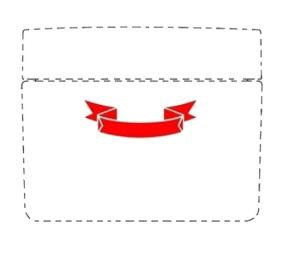
The trademark consists of a figure colored in red which is affixed to the upper half of the side of the main body of a packaging container for goods.
|
| No. 5805761 | K.K. Secoma | 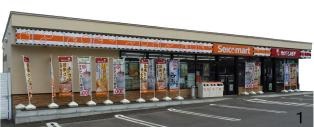
The trademark consists of a figure affixed to the upper part of a glass window or a wall surface of a shop served as advertising medium. The trademark consists of a combination of band shape figures colored in white, orange, and white in order from top to bottom, and a plurality of circle figures. A part surrounded by a black dashed line in the figure shows a position of the position mark.
|
| No. 5807881
|
EDWIN Co., Ltd. | 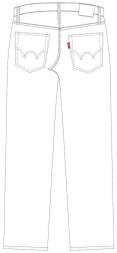
The trademark consists of a figure of a rectangle-shaped tab colored in red which is affixed to the left upper part of the back pocket of pants and on which the alphabetical letters “EDWIN” are displayed.
|
| No. 5858802 | Sony Interactive Entertainment Inc. | 
The trademark consists of three-dimensional shapes of buttons affixed to the upper right portion of a controller for operation of a game program.
|
| No. 5873740 | Kameda Seika Co., Ltd. | 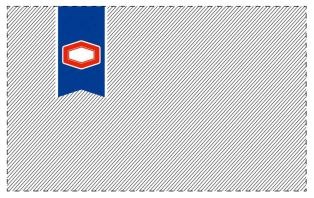
The trademark consists of a figure affixed to the upper left portion of a package container for rice confectionary or bean confectionary. The figure is composed of a vertical ribbon-like shape colored in blue, parts in contact with both left and right sides of the vertical ribbon-like shape which are colored in white, and a transversely elongated hexagonal shape formed with a thick red line which is arranged in the vertical ribbon-like shape, and a transversely elongated hexagonal shape formed with a thin red line which is arranged in the transversely elongated hexagonal shape formed with a thick red line, and a part in contact with the outer outline of the transversely elongated hexagonal shape which is colored in white, and the inner part of the transversely elongated hexagonal shape which is colored in white.
|
| No. 5874850 | Shiseido Co., Ltd. | 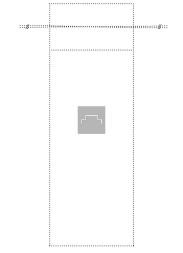
The trademark consists of a figure affixed to the upper half of the center of the front of a packaging bag for cleansing cotton.
|
| No. 5918807 | KYOCERA Corp. | 
The trademark consists of a form of a knife blade, a color applied to the whole surface of the knife blade, a figure affixed to the upper left of the knife blade, and the alphabetical letters ”KYOCERA”.
|
| No. 5960200 | Kewpie Corporation | 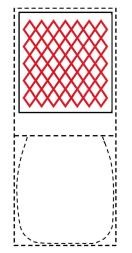
The trademark consists of a figure of a meshed pattern with thick red lines which is affixed to the upper approx. 2/5 part of the front face of a product package.
|
| No. 6015898 | Yamaha Corporation | 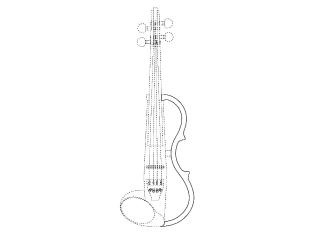
The trademark consists of a three-dimensional shape of a flame which exists only on the right side of an electric violin.
|
| No. 6028117 | FRED PERRY (HOLDINGS) LTD. | 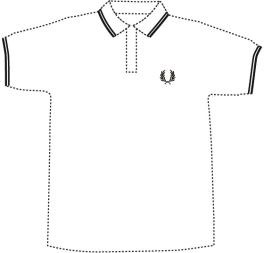
The trademark consists of a figure of a laurel wreath affixed to the left chest of a polo shirt, and double lines affixed around the edge of the collar and around both the sleeve openings.
|
| No. 6034112 | Nisshin Foods Holdings Co., Ltd. | 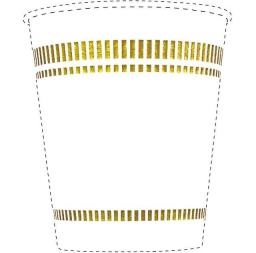
The trademark consists of a combination of a figure attached to the periphery upper part of a product package, and a figure attached to the periphery lower part of a product package.
|
| No. 6044632 | SSK CORPORATION | 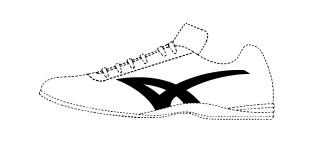
The trademark consists of a figure attached to the left side of a shoe.
|
| No. 6103554 | ITOCHU Corporation | 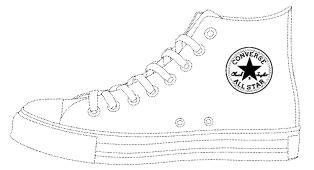
The trademark consists of the alphabetical letters “CONVERSE”, “Chuck Taylor”, and “ALL STAR”, a star-shaped figure, and a figure consisting of the alphabetical letter “R” enclosed in a circle, and which are attached to the side surface of shoes.
|
| No. 6125626 | Sakura Color Products Corp. | 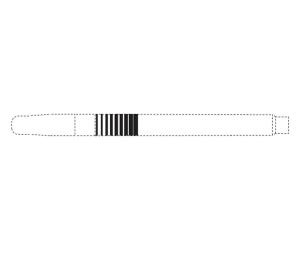
The trademark consists of a figure of a striped pattern affixed to the periphery of the penholder of an oil marking pen.
|
| No. 6183484 | Puma SE | 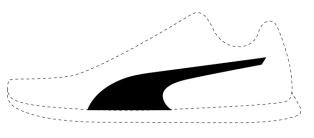
The trademark consists of a figure affixed to the side of the goods “footwear and boots for sports”
|
【Keywords】Shape of a packaging container of a product, position marks, Article 3, Paragraph 1, Item 3 of the Trademark Act, a trademark consisting solely of a mark indicating the shape of a product in a common manner, inherent distinctiveness, Article 3, Paragraph 2 of the Trademark Act, distinctiveness acquired through use, エバラ, 黄金の味
※ The contents of this article are intended to convey general information only and not to provide any legal advice.
Kei IIDA (Writer)
Attorney at Law & Patent Attorney (Daini Tokyo Bar Association)
Contact information for inquiries: k_iida@nakapat.gr.jp